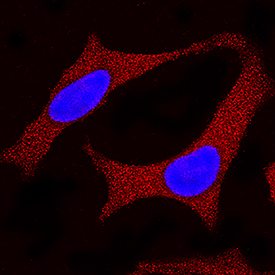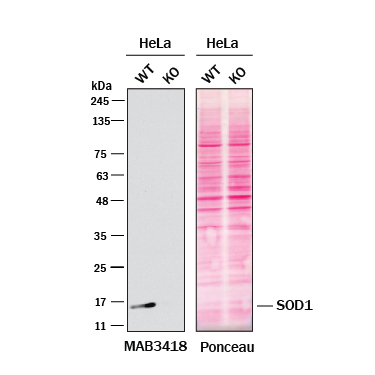Human SOD1/Cu-Zn SOD Antibody Summary
Met1-Gln154
Accession # P00441
Applications
Please Note: Optimal dilutions should be determined by each laboratory for each application. General Protocols are available in the Technical Information section on our website.
Scientific Data
 View Larger
View Larger
Detection of Human SOD1/ Cu‑Zn SOD by Western Blot. Western blot shows lysates of Jurkat human acute T cell leukemia cell line and Ramos human Burkitt's lymphoma cell line. PVDF membrane was probed with 0.5 µg/mL Mouse Anti-Human SOD1/Cu-Zn SOD Monoclonal Antibody (Catalog # MAB3418) followed by HRP-conjugated Anti-Mouse IgG Secondary Antibody (HAF007). For additional reference, recombinant human SOD1, SOD2, and SOD3 (1 ng) were included. A specific band for SOD1/Cu-Zn SOD was detected at approximately 16 kDa (as indicated). This experiment was conducted under reducing conditions and using Immunoblot Buffer Group 2.
 View Larger
View Larger
SOD1/Cu‑Zn SOD in HeLa Human Cell Line. SOD1/Cu-Zn SOD was detected in immersion fixed HeLa human cervical epithelial carcinoma cell line using Mouse Anti-Human SOD1/Cu-Zn SOD Monoclonal Antibody (Catalog # MAB3418) at 25 µg/mL for 3 hours at room temperature. Cells were stained using the NorthernLights™ 557-conjugated Anti-Mouse IgG Secondary Antibody (red; Catalog # NL007) and counterstained with DAPI (blue). Specific staining was localized to cytoplasm. View our protocol for Fluorescent ICC Staining of Cells on Coverslips.
 View Larger
View Larger
Western Blot Shows Human SOD1/Cu‑Zn SOD Specificity Using Knockout Cell Line. Western blot shows lysates of HeLa human cervical epithelial carcinoma cell line and SOD1/Cu‑Zn SOD knockout HeLa cell line (KO). Nitrocellulose membrane was probed with 0.5 µg/mL of Mouse Anti-Human SOD1/Cu‑Zn SOD Monoclonal Antibody (Catalog # MAB3418) followed by HRP-conjugated Anti-Mouse IgG Secondary Antibody. A specific band was detected for SOD1/Cu‑Zn SOD at approximately 16 kDa (as indicated) in the parental HeLa cell line, but is not detectable in knockout HeLa cell line. The Ponceau stained transfer of the blot is shown. This experiment was conducted under reducing conditions. Image, protocol, and testing courtesy of YCharOS Inc. See ycharos.com for additional details.
Reconstitution Calculator
Preparation and Storage
- 12 months from date of receipt, -20 to -70 °C as supplied.
- 1 month, 2 to 8 °C under sterile conditions after reconstitution.
- 6 months, -20 to -70 °C under sterile conditions after reconstitution.
Background: SOD1/Cu-Zn SOD
Superoxide Dismutases (SODs), originally identified as Indophenoloxidase (IPO), are enzymes that catalyze the conversion of naturally-occuring but harmful superoxide radicals into molecular oxygen and hydrogen peroxide. Superoxide Dismutases 1, SOD1, also known as Cu/Zn SOD, soluble SOD and IPO-A, is a soluble, cytoplasmic 16 kDa homodimer. Each SOD1 monomer binds one Cu2+ and one Zn2+ ion. Three isozymes of SOD have been identified and are functionally related but have very modest sequence homology. SOD1 shares 23% and 27% sequence identity with SOD2 and SOD3, respectively. Mutations in SOD1 have been implicated as causes of familial amyotrophic lateral sclerosis (ALS). The ALS-causing mutations of SOD1 are scattered throughout the protein and provide no clear functional or structural clues to the underlying disease mechanism. The oligomerization hypothesis suggests that mutant SOD1 proteins become misfolded and consequently oligomerize into high molecular weight aggregates that result in the death of motor neurons. The oxidative damage hypothesis suggests that loss of function mutation in SOD1 protein results in the accumulation of cellular superoxide radical, leading to free radical-mediated damage, the release of cytochrome c, and apoptosis.
Product Datasheets
Citation for Human SOD1/Cu-Zn SOD Antibody
R&D Systems personnel manually curate a database that contains references using R&D Systems products. The data collected includes not only links to publications in PubMed, but also provides information about sample types, species, and experimental conditions.
1 Citation: Showing 1 - 1
-
Activation of EGFR by small compounds through coupling the generation of hydrogen peroxide to stable dimerization of Cu/Zn SOD1.
Authors: Sakanyan V, Hulin P, Alves de Sousa R, Silva V, Hambardzumyan A, Nedellec S, Tomasoni C, Loge C, Pineau C, Roussakis C, Fleury F, Artaud I
Sci Rep, 2016-02-17;6(0):21088.
Species: Human
Sample Types: Cell Lysates
Applications: Western Blot
FAQs
No product specific FAQs exist for this product, however you may
View all Antibody FAQsReviews for Human SOD1/Cu-Zn SOD Antibody
Average Rating: 4 (Based on 2 Reviews)
Have you used Human SOD1/Cu-Zn SOD Antibody?
Submit a review and receive an Amazon gift card.
$25/€18/£15/$25CAN/¥75 Yuan/¥2500 Yen for a review with an image
$10/€7/£6/$10 CAD/¥70 Yuan/¥1110 Yen for a review without an image
Filter by:



